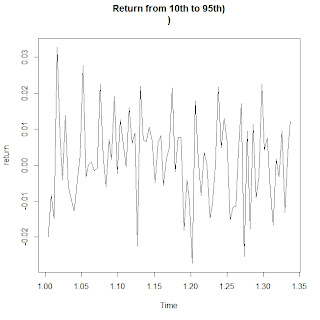#Assignment-1 Create log of the return data( way 1- log (st-st-1)/(st-1)
> #Historical volatility calculate.
> #Create acf plot for log(returns ) data and adf and interpret. NSE nifty index(from jan2012 to 31 jan 2013)
Program:
> z<-read.csv(file.choose(),header=T)
> closingprice<-z$Close
> closingprice.ts<-ts(closingprice,frequency=252)
> laggingtable<-cbind(closingprice.ts,lag(closingprice.ts,k=-1),closingprice.ts-lag(closingprice.ts,k=-1))
> Return<-(closingprice.ts-lag(closingprice.ts,k=-1))/lag(closingprice.ts,k=-1)
> Manipulate<-scale(Return)+10
> logreturn<-log(Manipulate)
> acf(logreturn)
From the figure it implies that the all the standard errors are within the 95% confidence interval and hence we can
say that the time series is stationary.
>T<-252^.5
>Historicalvolatility<-sd(Return)*T
> Historicalvolatility
[1] 0.1475815
> adf.test(logreturn)
Augmented Dickey-Fuller Test
data: logreturn
Dickey-Fuller = -5.656, Lag order = 6, p-value = 0.01
alternative hypothesis: stationary
Warning message:
In adf.test(logreturn) : p-value smaller than printed p-value
Since p-value is less than (1-.95) ,therefore we can say null hypothesis is rejected and hence the time series is stationary so data analysis can be done.
> #Historical volatility calculate.
> #Create acf plot for log(returns ) data and adf and interpret. NSE nifty index(from jan2012 to 31 jan 2013)
Program:
> z<-read.csv(file.choose(),header=T)
> closingprice<-z$Close
> closingprice.ts<-ts(closingprice,frequency=252)
> laggingtable<-cbind(closingprice.ts,lag(closingprice.ts,k=-1),closingprice.ts-lag(closingprice.ts,k=-1))
> Return<-(closingprice.ts-lag(closingprice.ts,k=-1))/lag(closingprice.ts,k=-1)
> Manipulate<-scale(Return)+10
> logreturn<-log(Manipulate)
> acf(logreturn)
From the figure it implies that the all the standard errors are within the 95% confidence interval and hence we can
say that the time series is stationary.
>T<-252^.5
>Historicalvolatility<-sd(Return)*T
> Historicalvolatility
[1] 0.1475815
> adf.test(logreturn)
Augmented Dickey-Fuller Test
data: logreturn
Dickey-Fuller = -5.656, Lag order = 6, p-value = 0.01
alternative hypothesis: stationary
Warning message:
In adf.test(logreturn) : p-value smaller than printed p-value
Since p-value is less than (1-.95) ,therefore we can say null hypothesis is rejected and hence the time series is stationary so data analysis can be done.




